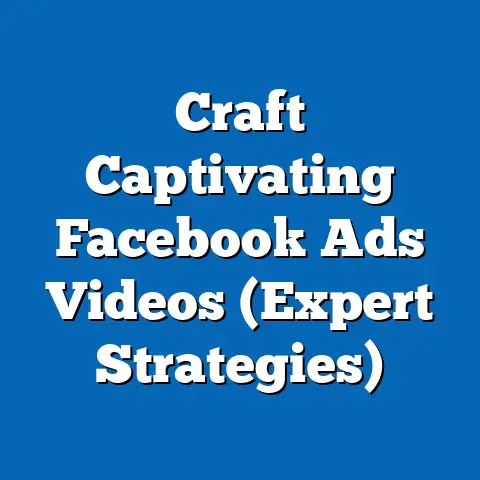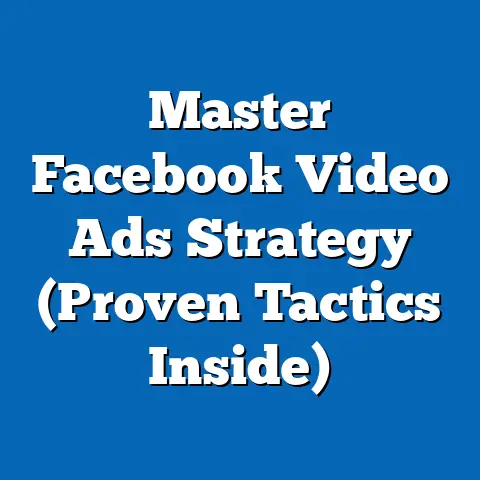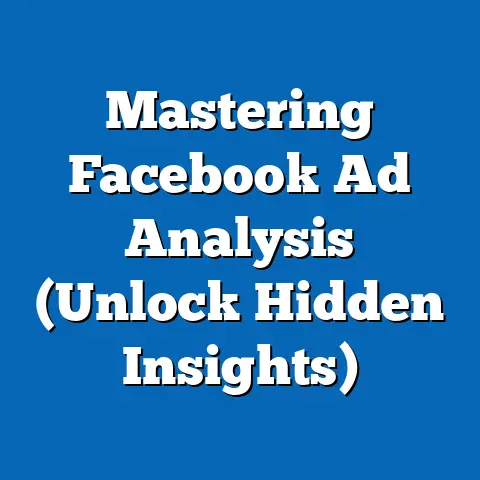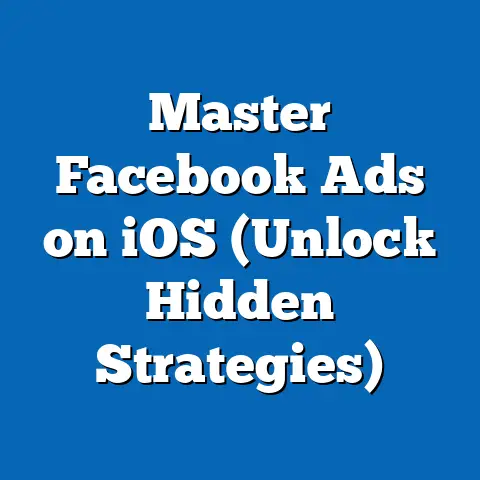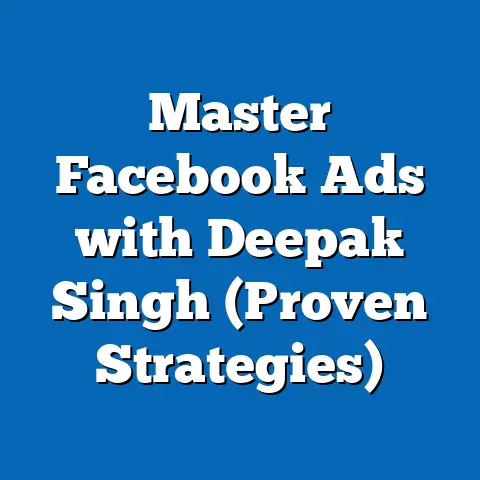Craft Irresistible Facebook Ad Descriptions (Pro Tips)
Facebook advertising, in my experience, is like a finely tuned engine that can drive incredible results for businesses of all sizes. I’ve seen startups explode onto the scene and established brands revitalize their reach, all thanks to the power of a well-executed Facebook ad campaign. But here’s a secret I’ve learned over years of running campaigns for diverse clients: many marketers obsess over the visuals – the perfect image, the captivating video – and meticulously target their audience, but they often overlook the true potential hidden within the humble ad description.
Think of it this way: you’ve crafted a stunning visual and laser-targeted your audience, but if your ad description falls flat, it’s like putting premium fuel into a car with a clogged engine. The power is there, but it can’t be unleashed. The truth is, a compelling ad description can be the difference between a scroll-past and a click-through, a lead generated and a missed opportunity, a sale closed and a customer lost. It’s the voice of your brand, the persuasive whisper that convinces someone to take action.
I’ve seen firsthand how a simple tweak to an ad description can dramatically increase click-through rates and conversions. One time, working with a local bakery, we changed their ad description from a generic “Delicious pastries, order now!” to a more evocative “Craving a warm, flaky croissant? Our bakers are whipping up fresh batches daily. Treat yourself today!” The result? A 40% increase in online orders.
This article is your guide to unlocking the “best-kept secret” in Facebook advertising: crafting irresistible ad descriptions. I’ll share my pro tips, gleaned from years of experience in the trenches, to help you captivate your audience, boost your click-through rates, and ultimately, drive serious results for your business.
Section 1: Understanding Your Audience
Before you even think about writing a single word, you need to intimately understand your audience. I always tell my clients, “You’re not selling to everyone; you’re selling to someone.” That “someone” is your target audience, and knowing them inside and out is paramount to writing ad descriptions that resonate.
Creating audience personas is a powerful tool. Think of a persona as a fictional representation of your ideal customer. Give them a name, an age, a job, hobbies, and even fears and aspirations. What are their pain points? What are they looking for? What language do they use?
For example, let’s say you’re selling eco-friendly cleaning products. You might create a persona named “Sarah,” a 35-year-old working mother who’s passionate about sustainability and healthy living. She’s concerned about the harsh chemicals in conventional cleaning products and is looking for safe, effective alternatives for her family.
Understanding Sarah’s concerns and values allows you to tailor your ad copy specifically to her. Instead of writing “Our cleaning products are eco-friendly,” you can write “Protect your family and the planet with our plant-based cleaning solutions. Gentle on your home, tough on grime.”
Tone and language are also crucial. If you’re targeting Gen Z, your ad copy will likely be more casual and playful than if you’re targeting Baby Boomers. Emotional triggers are another powerful tool. What motivates your audience? Are they driven by a desire for security, status, or belonging? Tap into those emotions in your ad descriptions.
I’ve found that conducting thorough market research is essential. Use surveys, polls, and interviews to gather insights into your target audience’s needs, preferences, and pain points. Facebook Insights is also a goldmine of information. It provides valuable data about your audience’s demographics, interests, and behaviors. Use this data to refine your audience personas and tailor your ad copy accordingly.
Key Takeaway: Understanding your audience is the foundation of effective ad copy. Create detailed audience personas, conduct market research, and utilize Facebook Insights to tailor your messaging to specific audience segments.
Section 2: The Art of Crafting the Perfect Hook
The first few words of your ad description are critical. They’re your chance to grab attention, pique curiosity, and entice readers to keep reading. Think of it as your elevator pitch – you have a limited amount of time to make a compelling impression.
I often use the “stop-the-scroll” test. Imagine your ad is appearing in someone’s Facebook feed. What will make them stop scrolling and actually pay attention? That’s the power of a strong hook.
There are several techniques you can use to craft a compelling hook:
- Ask a question: Questions are a great way to engage readers and make them think. For example, “Tired of sleepless nights?” or “Is your website losing customers?”
- Make a bold statement: Bold statements can be attention-grabbing and intriguing. For example, “The only diet you’ll ever need” or “The secret to a flawless complexion.”
- Create urgency: Urgency motivates readers to take action immediately. For example, “Limited-time offer! Ends tonight!” or “Don’t miss out on our biggest sale of the year!”
- Relatable scenario: Start with a scenario that your target audience can relate to. For example, “Imagine waking up feeling refreshed and energized” or “Picture yourself relaxing on a tropical beach.”
Let’s dissect some examples:
- “Struggling with dry, itchy skin this winter?” (Question): This hook immediately targets people who are experiencing a common problem during the winter months.
- “Finally, a workout program that fits your busy schedule.” (Bold statement): This hook appeals to people who struggle to find time for exercise.
- “50% off all items! Shop now before it’s too late.” (Urgency): This hook creates a sense of urgency and encourages immediate action.
- “Imagine waking up with perfectly defined eyebrows every day.” (Relatable scenario): This hook appeals to people who are interested in cosmetic procedures like microblading.
I’ve found that testing different hooks is essential. A/B test your ads with different opening lines to see which ones perform best. Pay attention to your click-through rates and conversion rates to determine which hooks are most effective at driving results.
Key Takeaway: Your hook is your first impression. Use questions, bold statements, urgency, or relatable scenarios to grab attention and entice readers to keep reading. A/B test different hooks to see which ones perform best.
Section 3: Highlighting Benefits, Not Features
This is a mistake I see marketers make all the time: focusing on features instead of benefits. A feature is a characteristic of your product or service, while a benefit is the value it provides to the customer.
For example, a feature of a vacuum cleaner might be that it has a powerful motor. The benefit, however, is that it can quickly and easily remove dirt and dust, leaving your home clean and healthy.
Customers don’t care about features; they care about benefits. They want to know how your product or service will solve their problems, make their lives easier, or improve their well-being.
Here’s a simple formula for transforming features into compelling benefits:
Feature + “Which means that…” = Benefit
Let’s apply this formula to a few examples:
- Feature: Our software has a drag-and-drop interface.
- Benefit: Our software has a drag-and-drop interface, which means that you can easily create stunning designs without any coding experience.
- Feature: Our coffee beans are ethically sourced.
- Benefit: Our coffee beans are ethically sourced, which means that you can enjoy a delicious cup of coffee knowing that you’re supporting sustainable farming practices.
- Feature: Our mattresses are made with memory foam.
- Benefit: Our mattresses are made with memory foam, which means that you’ll enjoy a comfortable and supportive night’s sleep, waking up feeling refreshed and energized.
- Benefit: Our software has a drag-and-drop interface, which means that you can easily create stunning designs without any coding experience.
- Benefit: Our coffee beans are ethically sourced, which means that you can enjoy a delicious cup of coffee knowing that you’re supporting sustainable farming practices.
- Benefit: Our mattresses are made with memory foam, which means that you’ll enjoy a comfortable and supportive night’s sleep, waking up feeling refreshed and energized.
I once worked with a fitness studio that was struggling to attract new clients. Their ads were focused on features like “state-of-the-art equipment” and “certified trainers.” We revamped their ad copy to focus on benefits: “Lose weight, build strength, and feel confident in your own skin” and “Transform your body and your life with our personalized fitness programs.” Their enrollment numbers skyrocketed.
Key Takeaway: Focus on the benefits your product or service provides to the customer, not just the features. Use the “Feature + ‘Which means that…’ = Benefit” formula to transform features into compelling benefits that resonate with your audience.
Section 4: The Power of Storytelling
People are naturally drawn to stories. They’re engaging, memorable, and emotionally resonant. Incorporating storytelling into your ad descriptions can make your ads more relatable and impactful.
I often tell my clients that advertising isn’t about selling; it’s about connecting. Storytelling is a powerful way to connect with your audience on an emotional level.
Here are a few tips for using storytelling in your ad descriptions:
I once ran a campaign for a charity that provides clean water to communities in developing countries. Instead of simply stating the facts and figures, we shared a story about a young girl who could finally attend school because she no longer had to spend hours each day fetching water. The ad resonated deeply with our audience and generated a significant increase in donations.
Key Takeaway: Use storytelling to make your ad descriptions more relatable and memorable. Share customer testimonials, tell personal anecdotes, or create fictional scenarios that connect with your audience on an emotional level.
Section 5: Incorporating a Clear Call to Action
Your call to action (CTA) is the final piece of the puzzle. It’s the instruction that tells your audience what you want them to do next. Without a clear CTA, your ad description is incomplete.
I always tell my clients, “Don’t leave your audience guessing. Tell them exactly what you want them to do.”
There are many different types of CTAs you can use, depending on your ad’s objective:
- Learn More: Use this CTA to drive traffic to your website or landing page.
- Shop Now: Use this CTA to encourage immediate purchases.
- Sign Up: Use this CTA to generate leads or build your email list.
- Download: Use this CTA to offer a free resource, such as an e-book or whitepaper.
- Contact Us: Use this CTA to encourage potential customers to reach out to you.
Tailor your CTA to fit your ad’s objective. If you’re running an ad to promote a new product, use a CTA like “Shop Now” or “Pre-Order Today.” If you’re running an ad to generate leads, use a CTA like “Sign Up for a Free Consultation” or “Download Our Free Guide.”
Make your CTA clear, concise, and action-oriented. Use strong verbs that inspire immediate action. Here are a few examples:
- Shop Now: Don’t just say “Click here.”
- Sign Up Today: Add a sense of urgency.
- Download Your Free Guide: Emphasize the value proposition.
- Get Started Now: Encourage immediate action.
I’ve found that testing different CTAs can significantly impact your ad’s performance. A/B test your ads with different calls to action to see which ones generate the best results.
Key Takeaway: Include a clear and compelling call to action in every ad description. Tailor your CTA to fit your ad’s objective and use strong verbs that inspire immediate action. A/B test different CTAs to see which ones perform best.
Section 6: Testing and Iteration
The world of Facebook advertising is constantly evolving. What works today might not work tomorrow. That’s why testing and iteration are so crucial.
I always tell my clients, “Advertising is a science, not an art. You need to test your hypotheses and analyze the data to see what works.”
A/B testing is a powerful tool for optimizing your ad descriptions. Create two versions of your ad with different descriptions and run them simultaneously. Track your click-through rates, conversion rates, and other key metrics to see which version performs better.
Once you have enough data, you can confidently declare a winner and use that description in your future ads. But don’t stop there! Continue testing and iterating to see if you can further improve your results.
Pay attention to your performance metrics. Click-through rate (CTR) is the percentage of people who see your ad and click on it. Conversion rate is the percentage of people who click on your ad and then take the desired action, such as making a purchase or signing up for a newsletter.
Analyze your data to identify trends and patterns. What types of hooks are performing best? What benefits are resonating most with your audience? What CTAs are driving the most conversions? Use these insights to refine your ad copy and improve your overall campaign performance.
I once worked with an e-commerce company that was struggling to generate sales through Facebook ads. We ran a series of A/B tests on their ad descriptions, testing different hooks, benefits, and CTAs. Through this iterative process, we were able to identify a winning combination that significantly increased their conversion rates and revenue.
Key Takeaway: Testing and iteration are essential for optimizing your ad descriptions. Use A/B testing to compare different versions of your ad copy and analyze your performance metrics to identify trends and patterns. Continuously refine your ad descriptions based on real-time feedback to improve your overall campaign performance.
Conclusion
Crafting irresistible Facebook ad descriptions is the “best-kept secret” to unlocking the full potential of your advertising efforts. By understanding your audience, crafting the perfect hook, highlighting benefits, incorporating storytelling, including a clear call to action, and embracing testing and iteration, you can captivate your audience, boost your click-through rates, and drive serious results for your business.
I encourage you to implement the pro tips I’ve shared throughout this article and to experiment with your writing style. Don’t be afraid to try new things and see what resonates with your audience. Remember, mastering ad copy is an ongoing process, but the rewards are well worth the effort. So, go out there and start writing ad descriptions that convert!

